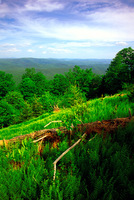 | Back to e-WV
| Back to e-WV
 The West Virginia Encyclopedia
The West Virginia Encyclopedia
 | Back to e-WV
| Back to e-WV
 The West Virginia Encyclopedia
The West Virginia Encyclopedia

Gaudineer Knob and the Gaudineer Scenic Area are named for Donald Gaudineer, a West Virginia forester who lost his life while trying to save his children in a house fire. Located on Cheat Mountain in Randolph and Pocahontas counties off U.S. 250 between Durbin and Cheat Bridge, it is an example of a high boreal island in the Allegheny Mountains with two forest types: northern evergreen (red spruce) and northern hardwoods (American beech, yellow birch, sugar maple).
Atop the knob, elevation 4,450 feet, the U.S. Forest Service maintains a scenic overlook and a picnic area. About a mile away is a tract of about 50 acres of virgin spruce and associated hardwoods, representing the original forest and including some trees more than three feet in diameter and 300 years old. Some of the flora and fauna are similar to that of northern New England and southern Canada.
The variety of birds found in summer, especially the wood warblers and four kinds of brown thrushes, attracts many visitors. Also found here is the rare and endemic Cheat Mountain salamander. It was discovered in 1935 on White Top Mountain, about three miles away. The endangered northern flying squirrel and the varying (snowshoe) hare also occur.
Written by George H. Breiding
Breiding, George H. Where North Meets South. Bird Watcher's Digest, (May-June 1995).
Carvell, Kenneth L. Gaudineer Knob. Wonderful West Virginia, (Sept. 1999).
"Gaudineer Scenic Area," Pamphlet. U.S. Forest Service, Monongahela National Forest.